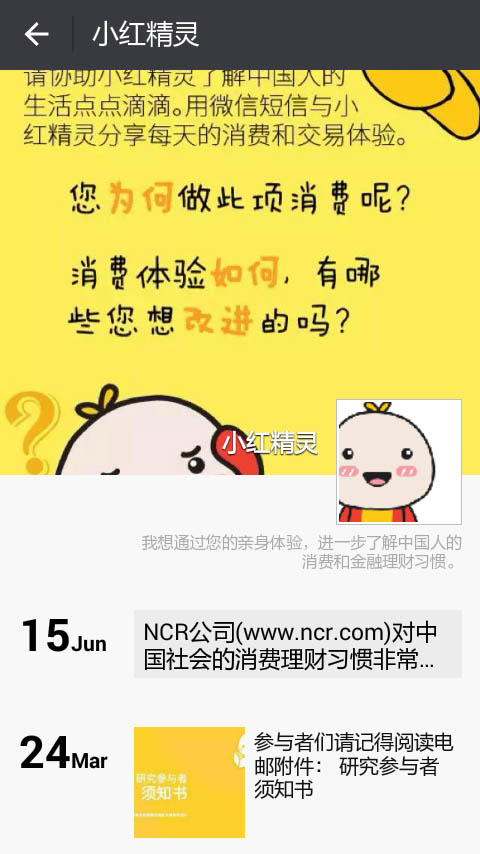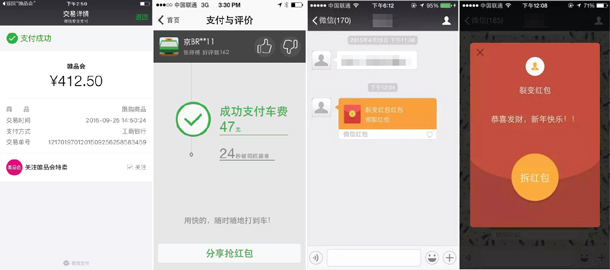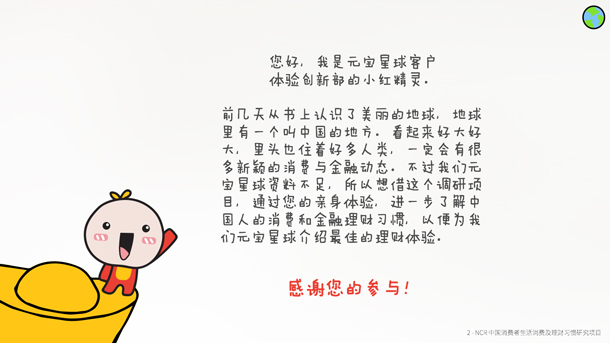In this article, we share considerations and lessons learned from using WeChat as a mobile diary that can be applied to future studies using chat apps.

The mobile diary is a great remote research tool to help uncover the daily lives of consumers and gather field-based consumer insights, especially as naturalistic data can be difficult to obtain through focus groups, interviews, or observations. This is particularly true when presented with geographical and temporal constraints. In a typical mobile diary study, participants record their reactions and responses to the subject matter (for example, brand communication, shopping activity) while on-the-go, on their own mobile devices, the very moment they experience them.
Our Singapore-based research team used an existing chat app, WeChat, as a diary tool during a series of mobile diary studies that focused on understanding how Chinese consumers go about their banking and financial activities in China. Use of an avatar rather than conventional human facilitation allowed us to engage more authentically with consumers and gather richer insights.
Finding the Right Tool
If we disregard China as the context (think firewall, app usage restrictions, and language barriers), there are a plethora of mobile diary tools available, ranging from paid to free, from custom apps to good old email. Custom mobile diary apps like dscout, ethos, and indeemo can be useful in research as they not only help collect information but also allow basic coding/tagging or grouping, enabling researchers to see data clearly.
Collaborative tools like Evernote and Google Docs also enable researchers to receive real-time updates from participants as they record their activity in text, photos, and/or audio.
However, for our study we wanted to leverage existing behaviors of how people communicated with loved ones, akin to documenting their lives as they chatted with their friends and families. This led us to considering chat apps as a tool. We wanted to avoid having participants purchase or experience potential difficulties using a new mobile app, especially since our participants lived within a different culture and used a different language than us.
Reducing the time needed for participants to grasp the technicalities of how to use a mobile diary study tool allowed us to devote more time to explain the value of the research and encourage their buy-in. Based on our previous experience, participants were willing to be more open, and, in turn, provide more valuable insights when they realized their recorded financial experiences could help banks provide them better services.
WeChat was selected for its ubiquity in China, with a reported 750-plus million users monthly, allowing us to benefit from participants’ familiarity. Other popular chat apps in Asia like Google Talk, Facebook Messenger, WhatsApp, Korea’s KakaoTalk, and Japan’s Line Messenger were disqualified due to China’s firewall and data restrictions.
In addition to chatting about their financial behavior using text, participants were encouraged to use pictures and voice messages. Some preferred recording audio while on the go, especially some older participants who seemed to be more comfortable with voice messages. Voice messages proved to be useful in that we could hear more contextual data, too. For example, we could hear the change in tone of voice if the participant was in a hurry or a hushed voice if speaking at home with a baby present.
Although the name WeChat suggests a chat focus, it also has a social media feature, allowing users to share posts with selected friends on their individual walls. Gaining access to users’ social media walls after participants added our WeChat account as a “friend” provided researchers a sense of overall lifestyle, allowing for cross-referencing wall postings with data collected from their diaries. Similarly, participants could refer to the objective of the study and download related content from the researcher’s wall.


Lastly, though not an initial consideration in selecting WeChat as the medium, the payment features on WeChat largely aided participants in understanding the nature of our study. Following the success of WeChat Red Packets (微信红包), which mimics the Chinese tradition of gifting money in physical red envelopes called hongbao (红包), Tencent has put considerable focus into WeChat Pay (微信支付), which can be used to transfer money between WeChat users (peer-to-peer) and make payments online and with participating offline retailers.
Leveraging familiarity (participants were all WeChat users), we referenced WeChat Pay features as examples of financial activities to record and discuss, on top of other common examples like visiting a bank or paying for groceries.

Someone to Talk To: Avatar as Researcher
Our initial challenge with the mobile diary was that participants assumed the diary facilitator understood the nuances underlying the recorded activity and bypassed cultural explanations. For example, a participant posted, “I spent 47yuan on taxi today,” but stopped short of explaining how exactly the payment was made. It was only via post-study interviews that we found taxis are commonly hired via mobile platforms such as DiDi in China, instead of flagging one off the street. Another challenge was that many were protective about personal financial habits or sharing such information with a stranger-researcher from a foreign land.
Given the social and conversational nature of WeChat, we turned to designing an agent to act as our face—our representative and voice. For our purposes, such a character needed to be friendly, approachable, culturally appropriate, and act like a curious outsider.

At the beginning of each study we introduced a curious cartoonish alien we named Little Red Sprite (小红精灵) wanting to understand ‘Earthlings’ to encourage participants to document in more detail, explaining their activities and all relevant Chinese cultural aspects–just as they would do for an interested non-local. Along with designing the agent to look endearing, we evaluated the mascots of China’s Internet giants and made Little Red Sprite’s conversation with participants more colloquial and playful.

Chatting Is What a Chat App Is About
Each study was 30 days long; with time participants’ posts started to be simpler, less frequent, and questions like, “Am I doing this right?” began appearing. We learned how crucial it was to close the loop while verifying our interpretations. To elicit a higher quality and quantity of posts, we leveraged WeChat’s sticker culture to engage in dialogue and reply to posts with customized stickers to appear more personable. The role of Little Red Sprite was critical here to prevent participants from being intimidated or overwhelmed by the requirements of the research. We believed an advantage of this type of avatar was in its social capability, essential to the continued dialogue. Care was taken to have Little Red Sprite display the emotions of gratitude and curiosity, as opposed to a tone of disappointment when posts were not made.
Also, participants were interviewed directly on WeChat posts, such as, “You mentioned heading to the supermarket with your credit card. Were there specific benefits of using a credit card?” Or, “I noticed your posts hardly mention shopping online. Do you usually shop online?” Dialogue not only demonstrated the kind of reciprocity that was inherently motivating, but also helped in drawing a detailed picture of the activity.
The relationships built up over the course of the diary study were also essential to the success of follow-up interviews conducted. The trust and familiarity gained by participants enabled intimate sharing as opposed to a rigid Q&A. Dialogue with participants on WeChat helped to scope questions for the follow-up interview phase, prompting in-depth questions like, “Could you explain why you have different credit cards and bank accounts for shopping online and shopping offline?”
Little Red Sprite, the agent, seemed to resonate well with participants and their responses were open and friendly, especially during the follow-up interviews. Participants addressed the researchers as “Little Red Sprite” and apologized through WeChat for not spending money or not posting. These were responses we had never received from previous (non-agent) studies! Their posts also had more explanations and included participants’ comments like, “Oh yes, you might not know, but in China giving your partner access to your bank account is a sign of trust. It’s common for girls to handle her boyfriend’s finances.”
Conclusion
Financial studies are often tricky because they involve sensitive data. Not everyone is open to sharing how much they spend, what they spend on, or how much they earn.
While our study was designed for the Chinese market and used a chat app locals were familiar with, the same principles can be applied to other markets and cultures where there is a high penetration of social chatting apps.
Participants’ understanding of how their responses were of value encouraged them to contribute more expressively and regularly. Enticing participants to continuously post about their day required vigilance and creativity in both feedback and encouragement.
The overall success of the technique was measured by the higher quality data (the amount of detailed and personal information) provided by participants, and by engagement (how frequently the participants posted). For some, posting even continued after receiving notice that the study had ended. The relationships developed (with Little Red Sprite) led to the success of the interviews, as trust and familiarity enabled more open, rich, and detailed conversations.
The study was made possible by NCR and we’d like to thank all of our research participants.
[greybox]
Translated Transcript from Figure 6
Hi, I’m Little Red Sprite from Planet Ingot and I currently work at the customer experience department. I discovered a book about Earth in the library the other day and saw that there was a country called China that’s filled with lots and lots of people. I was so excited and I’m sure there’s a lot to learn about how people on Earth experience banking. Unfortunately, I couldn’t find much information on my own, could you help me understand how you bank? I would like to learn and introduce better ways of banking back to Planet Ingot. Thanks for helping!
[/greybox]
